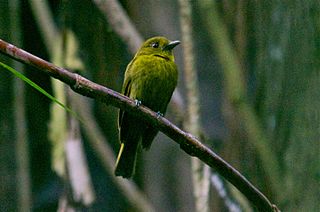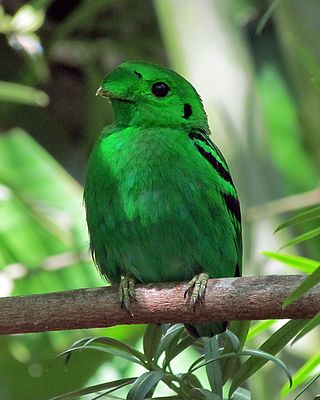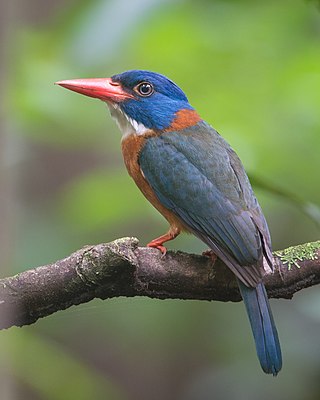
The long-tailed broadbill is a species of bird that is found in the Himalayas, extending east through Northeastern India to Southeast Asia. It is the only bird in the genus Psarisomus. The long-tailed broadbill is about 25 cm (10 inches) in length and weighs between 50 and 60 grams. It can be identified by its shrill call.

The sapayoa or broad-billed sapayoa is a suboscine passerine bird found Colombia, Ecuador, and Panama.

The green broadbill also known as the lesser green broadbill is a small bird in the family Calyptomenidae. It was formerly classified in the family Eurylaimidae, a group of closely related birds that share the name "broadbill".

The Yucatan amazon, also known as the yellow-lored amazon, Yucatan parrot or yellow-lored parrot is a species of bird in subfamily Arinae of the family Psittacidae, the African and New World parrots. It is found in Belize, Guatemala, Honduras, and Mexico.

The green-backed kingfisher is a species of bird in the family Alcedinidae endemic to Indonesia, where it is restricted to north and central Sulawesi, and the islands of Manadotua and Lembeh. It can be found in the protected areas of Lore Lindu, Bogani Nani Wartabone, and Tangkoko Batuangus.

Hose's broadbill is a species of bird in the family Calyptomenidae. It was described by the British naturalist Richard Bowdler Sharpe in 1892 and is named after the British zoologist Charles Hose, who collected the holotype of the species. It is 19–21 cm (7.5–8.3 in) long, with females weighing 92 g (3.2 oz) on average and males weighing 102–115 g (3.6–4.1 oz). Males are bright green and have conspicuous black spots on the wings, black markings on the head, blue underparts, black flight feathers, and a large green tuft covering most of the bill. Females have smaller forehead tufts, lime-green underparts with sky blue instead of azure blue on the undertail coverts, and lack black markings on the head, except for a black spot in front of the eye.

Whitehead's broadbill is a species of bird in the family Calyptomenidae. It is endemic to the mountain ranges of north-central Borneo, where it mainly inhabits montane forests and forest edges at elevations of 900–1,700 m (3,000–5,600 ft). It is 24–27 cm (9.4–10.6 in) long, with males weighing 142–171 g (5.0–6.0 oz) and females weighing 150–163 g (5.3–5.7 oz). Males are vivid green and have a black throat patch, black spots on the ear-coverts and back of the neck, and black markings and streaking all over the body. The tails and flight feathers are also blackish. Females are smaller and lack the black markings on the head and underparts. Juveniles look similar to adults but have fewer black markings.

The black-and-red broadbill is a species of bird in the typical broadbill family, Eurylaimidae. It is the only species in the genus Cymbirhynchus. A large, distinctive bird, it has maroon underparts, black upperparts, a maroon neck-band, and white bars on the wings. It also has a large, two-colored, blue-and-yellow bill. The species shows slight sexual dimorphism, with females being smaller than males. No other bird in its range resembles it, though the black-and-yellow broadbill has a similar call.

The northern barred woodcreeper is a sub-oscine passerine bird in subfamily Dendrocolaptinae of the ovenbird family Furnariidae. It is found from southern Mexico through Central America to Colombia, Venezuela and Ecuador.

The banded broadbill is a species of bird in the typical broadbill family Eurylaimidae found in Mainland Southeast Asia and the Greater Sunda Islands. It is sometimes split into two species, one including only the nominate subspecies, E. j. javanicus, and one including all the remaining subspecies. It inhabits a variety of forests, along with forest edge, rubber plantations and Falcataria falcata groves, mainly in lowland areas. A striking, large-bodied bird with a length of 21.5–23.0 cm (8.5–9.1 in), it is unlikely to be mistaken for another species. The broadbill is mostly purplish-red, with yellow-streaked black wings, a bright blue beak, a blackish face and greyish chin and upper breast. Females can be told apart from males by their lack of a black neckband, although these are indistinct in Bornean and Javan males. Despite its conspicuous appearance, the bird is usually hard to see due to its sluggishness and is usually only noticed when it vocalises.

The black-and-yellow broadbill is a species of bird in the typical broadbill family Eurylaimidae. A small, distinctive species, it has a black head, breastband, and upperparts, a white neckband, yellow streaking on the back and wings, and vinous-pink underparts that turn yellow towards the belly. The beak is bright blue, with a green tip to the upper mandible and black edges. It shows some sexual dimorphism, with the black breastband being incomplete in females.

The Visayan broadbill is a species of bird in the family Eurylaimidae where it was previously conspecific with the wattled broadbill. It is endemic to the islands of Samar, Leyte and Bohol in the central Philippines. Its natural habitat is tropical moist lowland forests. It is threatened by habitat loss.

The Melanesian flycatcher is a species of bird in the monarch-flycatcher family Monarchidae. The species is found on islands in Melanesia.

The Moluccan flycatcher or dark-grey flycatcher is a species of bird in the family Monarchidae. It is endemic to Indonesia.

Grauer's broadbill, also known as the African green broadbill, is a species of bird in the family Eurylaimidae, and is monotypic within the genus Pseudocalyptomena. Its name commemorates the German zoologist Rudolf Grauer who collected natural history specimens in the Belgian Congo.

The fire-eyes, Pyriglena, are a genus of birds in the antbird family Thamnophilidae.The genus contains 5 species, all found in South America. The fire-eyes are 16–18 cm in length, weigh 25-36 g and have characteristic red eyes that give them their name. They have sexually dimorphic plumage, with the females possessing brown to buff coloured bodies with black tails, and the males being black with small patches of white on the back or wings. The fire-eyes eat a variety of insects, and will regularly follow army ants in order to catch prey flushed by them. Two of the fire-eyes are widespread and safe, but one species, the fringe-backed fire-eye, is threatened with extinction.

The silver-breasted broadbill is a species of bird in the broadbill family, Eurylaimidae. There are seven currently recognised subspecies; the other species in the genus Serilophus, the grey-lored broadbill, was also previously treated as being a subspecies of this species.

The African broadbill, also known as the black-capped broadbill or Delacour's broadbill, is a species of bird in the sub-oscine family Calyptomenidae.

The Peruvian treehunter is a species of bird in the Furnariinae subfamily of the ovenbird family Furnariidae. It is found in Bolivia and Peru. It is also called the rufous-backed treehunter or buff-throated treehunter.

The Rondônia warbling antbird is a species of bird in the family Thamnophilidae. Until recently, it was considered a subspecies of the Guianan warbling antbird, but based on vocal differences and to a lesser degree differences in plumages they are now treated as separate species. As presently defined, the Rondonia warbling antbird is monotypic.





















